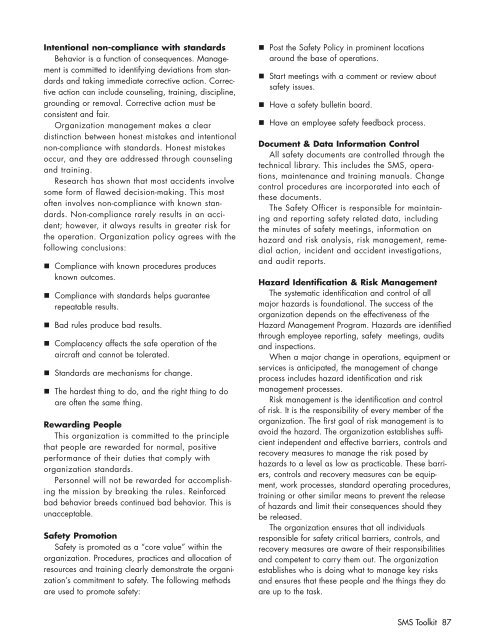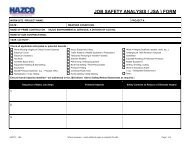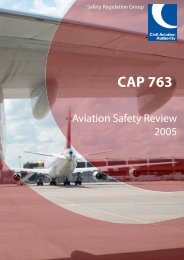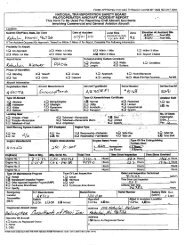International Helicopter Safety Team Safety Management System Toolkit
IHST - Safety Management Toolkit - Skybrary
IHST - Safety Management Toolkit - Skybrary
- No tags were found...
Create successful ePaper yourself
Turn your PDF publications into a flip-book with our unique Google optimized e-Paper software.
Intentional non-compliance with standards<br />
Behavior is a function of consequences. <strong>Management</strong><br />
is committed to identifying deviations from standards<br />
and taking immediate corrective action. Corrective<br />
action can include counseling, training, discipline,<br />
grounding or removal. Corrective action must be<br />
consistent and fair.<br />
Organization management makes a clear<br />
distinction between honest mistakes and intentional<br />
non-compliance with standards. Honest mistakes<br />
occur, and they are addressed through counseling<br />
and training.<br />
Research has shown that most accidents involve<br />
some form of flawed decision-making. This most<br />
often involves non-compliance with known standards.<br />
Non-compliance rarely results in an accident;<br />
however, it always results in greater risk for<br />
the operation. Organization policy agrees with the<br />
following conclusions:<br />
Compliance with known procedures produces<br />
known outcomes.<br />
Compliance with standards helps guarantee<br />
repeatable results.<br />
Bad rules produce bad results.<br />
Complacency affects the safe operation of the<br />
aircraft and cannot be tolerated.<br />
Standards are mechanisms for change.<br />
The hardest thing to do, and the right thing to do<br />
are often the same thing.<br />
Rewarding People<br />
This organization is committed to the principle<br />
that people are rewarded for normal, positive<br />
performance of their duties that comply with<br />
organization standards.<br />
Personnel will not be rewarded for accomplishing<br />
the mission by breaking the rules. Reinforced<br />
bad behavior breeds continued bad behavior. This is<br />
unacceptable.<br />
<strong>Safety</strong> Promotion<br />
<strong>Safety</strong> is promoted as a “core value” within the<br />
organization. Procedures, practices and allocation of<br />
resources and training clearly demonstrate the organization’s<br />
commitment to safety. The following methods<br />
are used to promote safety:<br />
Post the <strong>Safety</strong> Policy in prominent locations<br />
around the base of operations.<br />
Start meetings with a comment or review about<br />
safety issues.<br />
Have a safety bulletin board.<br />
Have an employee safety feedback process.<br />
Document & Data Information Control<br />
All safety documents are controlled through the<br />
technical library. This includes the SMS, operations,<br />
maintenance and training manuals. Change<br />
control procedures are incorporated into each of<br />
these documents.<br />
The <strong>Safety</strong> Officer is responsible for maintaining<br />
and reporting safety related data, including<br />
the minutes of safety meetings, information on<br />
hazard and risk analysis, risk management, remedial<br />
action, incident and accident investigations,<br />
and audit reports.<br />
Hazard Identification & Risk <strong>Management</strong><br />
The systematic identification and control of all<br />
major hazards is foundational. The success of the<br />
organization depends on the effectiveness of the<br />
Hazard <strong>Management</strong> Program. Hazards are identified<br />
through employee reporting, safety meetings, audits<br />
and inspections.<br />
When a major change in operations, equipment or<br />
services is anticipated, the management of change<br />
process includes hazard identification and risk<br />
management processes.<br />
Risk management is the identification and control<br />
of risk. It is the responsibility of every member of the<br />
organization. The first goal of risk management is to<br />
avoid the hazard. The organization establishes sufficient<br />
independent and effective barriers, controls and<br />
recovery measures to manage the risk posed by<br />
hazards to a level as low as practicable. These barriers,<br />
controls and recovery measures can be equipment,<br />
work processes, standard operating procedures,<br />
training or other similar means to prevent the release<br />
of hazards and limit their consequences should they<br />
be released.<br />
The organization ensures that all individuals<br />
responsible for safety critical barriers, controls, and<br />
recovery measures are aware of their responsibilities<br />
and competent to carry them out. The organization<br />
establishes who is doing what to manage key risks<br />
and ensures that these people and the things they do<br />
are up to the task.<br />
SMS <strong>Toolkit</strong> 87







